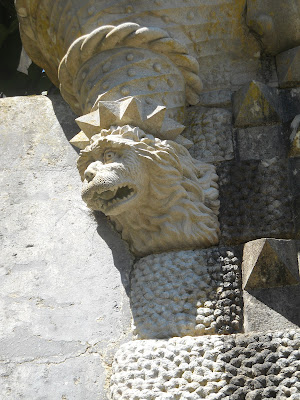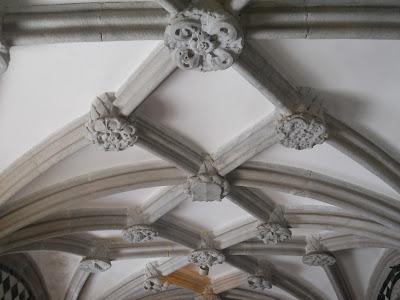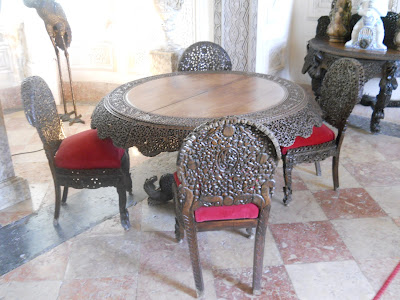 |
| Image from http://casadovalle.blogspot.co.uk/2012/10/pena-palace.html |
The palace was one of the first buildings in Europe to be constructed in the Romantic tradition, and is a mash-up of architectural styles: Arabic, Manueline Portuguese and Gothic all have their part.
It is filled with incredible pieces of artwork in ceramic, wood, stone and metal. The centre of the palace is built around the original sixteenth-century monastery cloisters, decorated with Hispano-Arabic tiles from around 1520:
Perhaps the most famous carving in the Palace is this one over the front courtyard, which represents Triton and illustrates the birth of the world:
The outside courtyards have some other impressive stone carvings overlooking them:
Little carved decorative details are everywhere as you walk through the buildings:
I am curious about who the caricature faces below are supposed to represent. King Don Manuel I gave the convent of Our Lady of Pena (around which the palace is built) to the Order of the Hieronymites in 1503, after becoming king in 1495.
In the 15th century, the nearby Castelo dos Mouros (Moorish castle) was inhabited by Jewish settlers who were segregated from the rest of the community by the king's orders.
Do these carved faces recall unpleasant anti-semitic feelings in the area at that time? Do they represent something or someone else? Or are they a more innocent jest?
The decorative carving is not confined to stone however, there are also some amazing carved wooden pieces to be seen. Flash photography and tripods are not permitted inside the palace, so unfortunately the images are a little blurry, but I hope that they give an idea of the quality of the work on display:























No comments:
Post a Comment